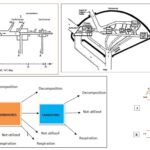Describe and carry out a test to identify the presence of non-reducing sugars, using acid hydrolysis and Benedict’s solution
AS and A Level Biology 220 Views 1 Answers
Sourav PanLv 9October 28, 2024
describe and carry out a test to identify the presence of non-reducing sugars, using acid hydrolysis and Benedict’s solution
Please login to save the post
Please login to submit an answer.
Sourav PanLv 9May 15, 2025
To test for the presence of non-reducing sugars, such as sucrose, you can use acid hydrolysis followed by Benedict’s test. Here’s a step-by-step guide on how to carry out this test:
Materials Needed:
- Sample solution (containing the suspected non-reducing sugar)
- Hydrochloric acid (HCl)
- Sodium hydroxide (NaOH) or sodium bicarbonate
- Benedict’s solution
- Test tubes
- Boiling water bath
- Dropper or pipette
Procedure:
- Initial Benedict’s Test:
- Add a small amount of Benedict’s solution to the sample solution in a test tube.
- Place the test tube in a boiling water bath for 2–3 minutes.
- Observe for any color change.
- If there is no color change (solution remains blue), this suggests that no reducing sugars are present, so you can proceed to test for non-reducing sugars.
- If a color change occurs (e.g., to green, yellow, orange, or red), this indicates the presence of reducing sugars, and the test for non-reducing sugars is not necessary.
- Acid Hydrolysis:
- Add a few drops of dilute hydrochloric acid (HCl) to a fresh sample of the solution in a test tube.
- Heat the mixture in a boiling water bath for about 5 minutes to hydrolyze the non-reducing sugars (like sucrose) into their constituent reducing sugars (like glucose and fructose).
- Neutralization:
- After heating, carefully add sodium hydroxide (NaOH) or sodium bicarbonate to neutralize the acid, as Benedict’s solution requires a neutral or slightly alkaline environment to work properly.
- Test with pH paper to ensure the solution is neutral.
- Benedict’s Test (Second Round):
- Add Benedict’s solution to the neutralized mixture.
- Place the test tube back in the boiling water bath for 2–3 minutes.
- Observe Results:
- Positive result: The solution changes color (green, yellow, orange, or brick-red precipitate) indicating the presence of reducing sugars that were initially non-reducing sugars.
- Negative result: The solution remains blue, indicating no non-reducing sugars were present.
Explanation:
The acid hydrolysis breaks down non-reducing sugars into reducing sugars, which can then react with Benedict’s solution to produce a color change, indicating their presence.
0
0 likes
- Share on Facebook
- Share on Twitter
- Share on LinkedIn
0 found this helpful out of 0 votes
Helpful: 0%
Helpful: 0%
Was this page helpful?




